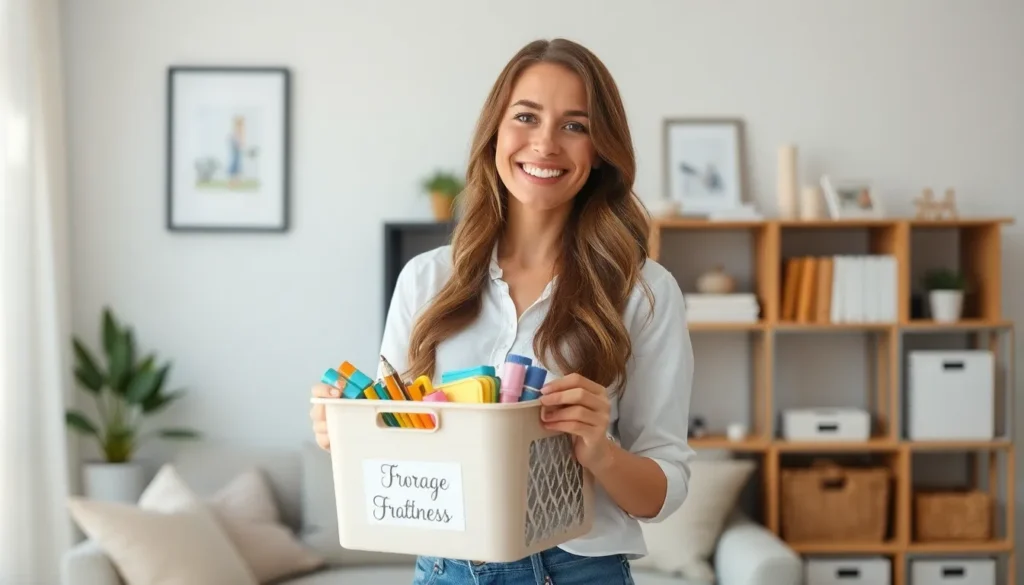Living with ADHD can feel like trying to herd cats in a tornado. The chaos of everyday life often makes organization seem like an impossible dream. But fear not! With the right home organization hacks, even the most scattered minds can create a sanctuary of order amidst the delightful chaos.
Table of Contents
ToggleUnderstanding ADHD and Home Organization
ADHD impacts daily life significantly, affecting attention, focus, and impulse control. Successful home organization brings order to the chaos that often accompanies ADHD.
The Unique Challenges of ADHD
Individuals with ADHD face unique challenges that complicate home organization. Distractions can easily divert attention, making it difficult to complete tasks. Forgetfulness disrupts routines, leading to misplacing items and lack of consistency. Procrastination pervades due to overwhelming feelings associated with organization. Spaces often become cluttered quickly, as maintaining order requires sustained focus and effort.
Benefits of Effective Organization for ADHD
Effective organization brings numerous benefits for those living with ADHD. Streamlined spaces reduce distractions, creating a calm environment conducive to focus. Organized items enhance accessibility, eliminating time spent searching for lost belongings. Structured routines foster consistency, building habits that positively influence productivity. Increased control over one’s environment reduces anxiety, contributing to overall well-being.
Essential ADHD Home Organization Hacks

Effective organization transforms chaotic living spaces into tranquil environments for individuals with ADHD. Utilizing practical strategies makes navigating daily tasks simpler.
Visual Aids and Labels
Visual aids enhance understanding and recall in ADHD home organization. Color-coded labels simplify recognizing items, reducing time spent searching for products. It’s important to incorporate charts or diagrams in the organization process; these tools provide clear visual cues. Using picture labels also benefits individuals who may struggle with reading. Keeping labels on all storage bins and shelves reinforces memory pathways and accountability. This approach turns cluttered areas into easily manageable spaces.
Creating Designated Spaces
Designated spaces help individuals with ADHD maintain order and predictability. Establishing a specific spot for each category of items streamlines daily routines. Allocating zones for work materials, personal belongings, and relaxation areas minimizes distractions. Assigning dedicated areas for essential items like keys or wallets prevents last-minute searches. Emphasizing consistency in placing items in their designated spots reduces stress levels and promotes efficiency. This method fosters a greater sense of control and helps establish productive habits.
Time Management Techniques
Effective time management techniques can significantly benefit individuals with ADHD. Utilizing specific strategies helps improve focus and organization, leading to increased productivity.
Using Timers and Alarms
Timers and alarms prove valuable tools for managing time. Setting a timer for intervals, such as 25 minutes, encourages focused work sessions, followed by a five-minute break. Alarms can signal the start of a task or remind individuals about appointments. This structured approach reduces anxiety related to time constraints and creates a sense of urgency. Regularly using these devices fosters a habit of time awareness, helping to combat distractions.
Breaking Tasks into Smaller Steps
Breaking tasks into smaller steps simplifies overwhelming projects. Start by listing each component, prioritizing based on urgency and importance. Completing one small task at a time makes it easier to stay focused and avoid feeling overwhelmed. Individuals gain a sense of accomplishment with each completed step, motivating them to continue working. Using checklists also boosts accountability while providing a clear visual of progress. Establishing this method can lead to effective task completion and enhanced organization over time.
Simplifying Daily Routines
Establishing daily routines creates structure and predictability for individuals with ADHD. This approach can enhance focus and reduce anxiety by providing clear expectations.
Establishing a Consistent Schedule
Creating a consistent schedule helps individuals manage their time effectively. Regular wake-up and sleep times contribute to better sleep hygiene, which supports overall cognitive function. Incorporating daily activities within blocks of time allows for focused work periods and breaks. Designating specific days for particular tasks, such as laundry or grocery shopping, can streamline chores and minimize decision fatigue. Using a shared calendar or planner keeps everyone informed and helps prioritize tasks, ensuring nothing important is overlooked.
The Importance of Checklists
Checklists serve as essential tools for maintaining organization and productivity. They break larger tasks into manageable steps, reducing overwhelm. An effective checklist promotes accountability by providing a visual representation of progress. This method allows individuals to celebrate small victories as they complete items. Including deadlines alongside task lists enhances urgency and motivation. Tailoring checklists for specific activities, such as packing for a trip or preparing for school, makes them even more reliable, leading to improved routine adherence and overall organization.
Tools and Resources for Organization
Various tools and resources enhance home organization for individuals with ADHD. These aids simplify daily management and foster a more cohesive living environment.
Digital Apps for Home Management
Mobile apps provide effective solutions for home organization. Users benefit from tools like Todoist or Trello to create task lists, enabling them to track both daily chores and long-term projects. Calendar apps such as Google Calendar allow for reminders and scheduling, making it easier to adhere to routines. Additionally, organization apps like Evernote help individuals archive notes, grocery lists, and ideas in one accessible location. By utilizing these digital solutions, individuals gain enhanced visibility on tasks, reducing anxiety and improving focus.
Physical Tools for Clutter Control
Physical tools play a crucial role in maintaining an organized home. Clear storage bins support item categorization, making it easier to find belongings and minimize clutter. Multi-compartment organizers help separate various items, reducing distractions during daily tasks. Utilizing wall-mounted shelves keeps frequently used items within reach while maximizing floor space. Labels assist in identifying contents, enhancing memory recall through visual cues. Incorporating these physical resources leads to a streamlined environment, allowing individuals to navigate their space with increased ease and confidence.
Embracing effective home organization hacks can significantly transform the lives of individuals with ADHD. By implementing visual aids designated spaces and time management techniques they can create a more structured and peaceful environment. These strategies not only reduce distractions but also enhance focus and productivity.
Incorporating digital tools and physical resources further streamlines organization efforts making everyday tasks more manageable. With the right approach individuals can cultivate habits that foster a sense of control over their surroundings. Ultimately this leads to improved well-being and a more fulfilling daily life.













